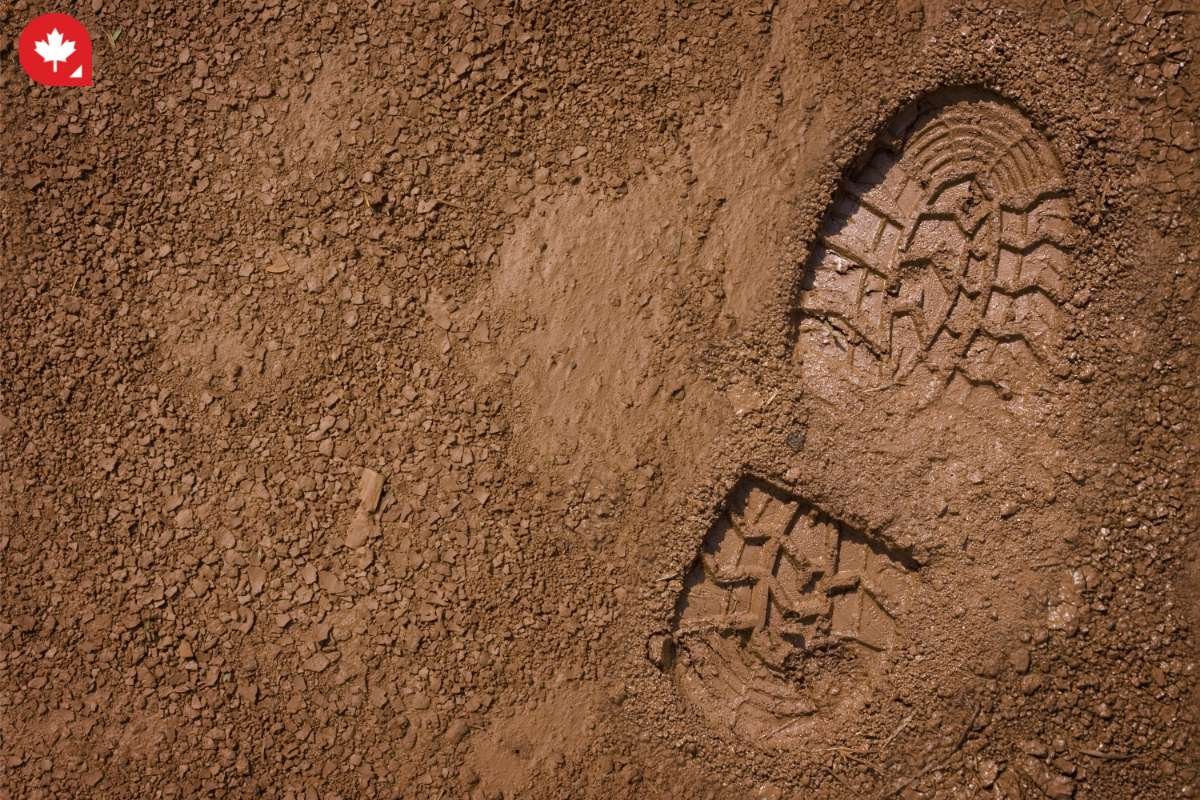Canada is renowned for its breathtaking landscapes, diverse wildlife, and four distinct seasons. However, for newcomers to Canada, the transition from winter to spring - affectionately known as "mud season" - can be an unexpected challenge. Between late March and early May, melting snow transforms roads, hiking trails, and backyards into slippery, muddy obstacle courses.
This guide will help you understand mud season in Canada, prepare for its challenges, and even find ways to embrace it. We'll cover essential gear, transportation tips, home maintenance, and fun things to do during this messy yet fascinating time of year.
What is Mud Season in Canada?

Mud season in Canada occurs when winter's snow begins to melt, but the ground remains partially frozen. Since the thawed top layer can't absorb all the water, it turns into thick, sticky mud. This phenomenon is especially noticeable in rural areas, cottage country, and hiking trails, where unpaved roads and pathways become nearly impassable.
Why Does Mud Season Happen?
Canada's long, snowy winters leave behind deep snowpack. When temperatures rise in early spring, the meltwater saturates the soil. Because nights can still dip below freezing, the ground repeatedly thaws and refreezes, creating uneven, muddy terrain. In some regions, heavy rainfall exacerbates the problem, turning dirt roads into quagmires.
How Long Does Mud Season in Canada Last?
The duration of mud season varies across the country. In southern Ontario and British Columbia, it typically lasts two to four weeks from late March to mid-April. The Prairies (Alberta, Saskatchewan, Manitoba) experience three to five weeks of mud season from April to early May. Atlantic Canada and Quebec often endure four to six weeks of muddy conditions, sometimes prolonged by spring rains. Northern Canada faces up to 6 weeks of unstable ground, with some areas experiencing dramatic shifts due to permafrost thaw.
Regional Differences During Mud Season
British Columbia's coastal cities like Vancouver see relatively little mud, but rural areas such as the Cariboo region deal with significant slush. The Prairies' flat terrain leads to large, waterlogged fields and muddy backroads that can challenge even experienced drivers. Ontario and Quebec face a mix of urban slush and rural mud, with many hiking trails in provincial parks closing temporarily to prevent erosion. Atlantic Canada, particularly Newfoundland, experiences extended mud seasons due to frequent rainfall and rugged landscapes. In the North, permafrost areas undergo dramatic ground shifts that make roads and walkways dangerously uneven.
Essential Gear for Surviving Mud Season
To stay comfortable during mud season, having the right gear is absolutely crucial. The first line of defense is proper footwear. A good pair of waterproof rubber boots from brands like Hunter or Bogs will serve you well, while insulated hiking boots with strong traction are better for colder days.
Clothing Essentials
Your clothing choices can make a world of difference during this messy season. A waterproof jacket with pit zips for ventilation will keep you dry without causing overheating. Quick-dry pants are far superior to denim, which stays wet and cold for hours after getting muddy.
Home and Vehicle Preparation
At home and in your vehicle, several key items will help manage the mess. Heavy-duty doormats placed both outside and inside your entrance will trap most of the mud. Boot trays positioned near doorways contain the worst of the mess, while all-weather floor mats in your car protect against mud and slush.
Getting Around During Mud Season
Navigating mud season requires some thoughtful adjustments to your transportation routines. If you're driving, it's wise to avoid rural backroads whenever possible, as these are often the muddiest and most difficult to traverse.
For Pedestrians and Hikers
For those on foot, sticking to paved paths in urban areas helps avoid unnecessary slipping. If you're an avid hiker, focus on gravel or well-drained trails—many provincial parks post updated trail conditions online during this season.
Keeping Your Home Clean
Mud season inevitably means extra dirt being tracked inside, but with some strategic planning, you can minimize the mess. Creating a designated mudroom zone near your main entrance is one of the most effective solutions.
Pet Care
Pet owners face particular challenges during mud season. Establishing a routine of wiping your dog's paws after every walk will significantly reduce the amount of dirt coming inside. Some homeowners find it helpful to keep a shallow basin of water near the door for rinsing off particularly muddy boots before entering.
Floor Cleaning
Protecting your floors requires some extra attention during these weeks. Investing in washable rugs for high-traffic areas makes cleanup much easier. You'll likely need to mop more frequently - a simple solution of vinegar and water works well to cut through the grime without leaving chemical residues.
Fun Things to Do in Canada During Mud Season

Despite the messy conditions, there are still plenty of enjoyable activities to experience during Canada's spring transition. Early spring hiking can be rewarding if you choose your trails wisely. While some paths may be muddy, others remain accessible, offering fresh air, budding trees, and the first signs of wildlife stirring from winter hibernation.
Go on a Maple Syrup Adventure
For a uniquely Canadian experience, consider visiting one of the many maple syrup festivals held in March and April. These events often feature demonstrations of traditional syrup-making techniques, and there's nothing quite like enjoying fresh syrup on pancakes or trying snow taffy made with the season's last snow. Many sugar shacks also offer wagon rides, live music, and family-friendly activities that make for a perfect day out.
Explore Early Spring Hiking Trails
If you're an outdoor enthusiast, early spring hiking can be surprisingly enjoyable—just be sure to pick trails that drain well and aren't prone to deep mud. Boardwalk trails, rocky paths, or forested areas with good elevation are great choices. Some national and provincial parks remain open year-round, offering stunning views of melting rivers, awakening wildlife, and the fresh scent of spring in the air.
Enjoy a Relaxing Spa Retreat
With the chill of winter fading but summer not quite here, a spa retreat is a perfect way to embrace the season. Many resorts and hot springs across Canada, such as those in Banff, Quebec, or British Columbia, offer outdoor thermal pools where you can soak in warm waters while surrounded by breathtaking landscapes. It's an excellent way to unwind and recharge during the unpredictable spring weather.
Try Spring Skiing or Snowshoeing
In higher elevations, mud season doesn’t mean the end of winter sports. Resorts in the Rockies, Quebec, and British Columbia often extend their ski and snowboard seasons into April. Spring skiing offers the best of both worlds—softer snow, fewer crowds, and milder temperatures. If skiing isn’t your thing, snowshoeing on remaining snow-covered trails is another fun way to stay active and enjoy the great outdoors.
Discover Seasonal Wildlife Watching
As the snow melts and nature comes back to life, spring is a great time for wildlife watching. Canada’s national parks and nature reserves provide opportunities to spot deer, moose, beavers, and migrating birds returning north. If you're lucky, you might even see bear cubs emerging from hibernation. Coastal areas offer excellent whale-watching opportunities as certain species begin their migration.
Visit a Historic Town or Cultural Site
Spring is a fantastic time to explore Canada’s rich history and culture. Historic towns like Quebec City, Niagara-on-the-Lake, or Lunenburg offer charming streets to wander without the peak summer crowds. Many museums and cultural sites also host spring exhibits and events, making it a great time to dive into Canada’s past.
Experience Spring Festivals and Events
Mud season coincides with several lively festivals across Canada. In addition to maple syrup festivals, you can find flower festivals, food and wine events, and arts celebrations marking the arrival of spring. Whether it’s the Cherry Blossom Festival in Vancouver, the Poutine Festival in Ottawa, or smaller community fairs, there's always something fun happening.
Go on a Road Trip to See the Changing Scenery
A spring road trip is a fantastic way to witness Canada’s landscapes waking up from winter. From the thawing lakes of Ontario’s cottage country to the dramatic mountain scenery in the Rockies, each region offers something unique. Pack some warm layers, prepare for unpredictable weather, and enjoy the beauty of Canada's changing season from the comfort of your car.
Spring may be a muddy transition, but it’s also full of adventure, fresh starts, and fun experiences waiting to be explored.
Health and Safety Tips
Navigating mud season safely requires some special precautions. Icy patches often lurk beneath the mud, especially in shaded areas or during early mornings.
A Different Style of Walking
Adopting the "penguin walk", taking short steps and keeping your feet flat, can help prevent slips and falls on uncertain surfaces.
Keep Fit
Maintaining an exercise routine might require some creativity during the muddiest weeks. Indoor activities like swimming, gym workouts, or yoga classes can keep you active while avoiding the worst of the outdoor mess.
Prepare For Allergies
Allergy sufferers should prepare for the onset of spring pollen, which can trigger sneezing fits and watery eyes as the season progresses. Over-the-counter antihistamines, nasal sprays, and keeping windows closed during high pollen counts can help manage symptoms.
Embracing Mud Season

While mud season presents undeniable challenges, it's important to remember that it's a fleeting part of living in Canada. With the right preparation and mindset, you can stay relatively dry, keep your home clean, and even find ways to enjoy this transitional period.
The muddy weeks give way to lush green landscapes and the full glory of Canadian spring, making all the temporary inconvenience worthwhile. Before you know it, the mud will dry, the trails will reopen, and summer adventures will begin.
In the meantime, take pride in having survived this uniquely Canadian experience. What's your biggest mud season challenge? Have you discovered any clever solutions for dealing with the mess?
FAQS
Are There Any Areas of Canada That Don't Experience Mud Season?
Major urban centers with extensive paved surfaces (like downtown Toronto or Vancouver) experience minimal mud season effects. However, even these cities will have muddy parks and trails during this period.
How do Canadians Keep Their Cars Clean During Mud Season?
Many Canadians invest in unlimited car wash passes during spring. It's also common to keep microfiber towels in the car for quick cleanups and to use all-weather floor mats that can be easily removed and hosed off.
Is it Safe to Hike During Mud Season in Canada?
Many official trails close during peak mud season to prevent erosion and damage. If you do hike, stick to lower-elevation trails and be prepared for extremely muddy conditions. Always check trail status with local parks before heading out.



